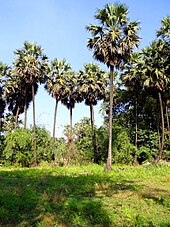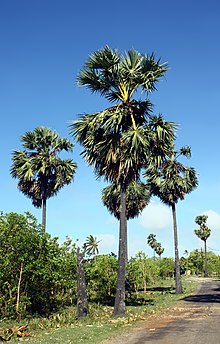In Indonesia the leaves were used in the ancient culture as paper, known as "lontar". Leaves of suitable size, shape, texture, and maturity were chosen and then seasoned by boiling in salt water with turmeric powder, as a preservative. The leaves were then dried. When they were dry enough, the face of the leaf was polished with pumice, cut into the proper size, and a hole made in one corner. Each leaf made four pages. The writing was done with a stylus and had a very cursive and interconnected style. The leaves were then tied up as sheaves.
Trunk
The stalks are used to make fences and also produce a strong, wiry fiber suitable for cordage and brushes. The black timber is hard, heavy, and durable and is highly valued for construction. In Cambodia, the trunks are also used to make canoes.

Cultivation
Borassus flabellifer has a growth pattern, very large size, and clean habits that make it an attractive ornamental tree, cultivated for planting in gardens and parks as landscape palm species.
Cultural symbolism
1) The palmyra tree is the official tree of Tamil Nadu. Highly respected in Tamil culture, it is called "karpaha Veruksham" ("celestial tree") because all its parts have a use. Panaiveriyamman, named after panai, the Tamil name for the Palmyra palm, is an ancient tree deity related to fertility linked to this palm. This deity is also known as Taalavaasini, a name that further relates her to all types of palms.

2) The palm is also common in Thailand, especially in the northeast or Isaan area, where it is a prevailing part of the landscape.
- Wikipedia
Trunk
The stalks are used to make fences and also produce a strong, wiry fiber suitable for cordage and brushes. The black timber is hard, heavy, and durable and is highly valued for construction. In Cambodia, the trunks are also used to make canoes.

Sugar palm as seen in Mumbai,India
Cultivation
Borassus flabellifer has a growth pattern, very large size, and clean habits that make it an attractive ornamental tree, cultivated for planting in gardens and parks as landscape palm species.
Cultural symbolism
1) The palmyra tree is the official tree of Tamil Nadu. Highly respected in Tamil culture, it is called "karpaha Veruksham" ("celestial tree") because all its parts have a use. Panaiveriyamman, named after panai, the Tamil name for the Palmyra palm, is an ancient tree deity related to fertility linked to this palm. This deity is also known as Taalavaasini, a name that further relates her to all types of palms.

Borassus flabellifer in Cambodia, 1965.
2) The palm is also common in Thailand, especially in the northeast or Isaan area, where it is a prevailing part of the landscape.
- Wikipedia











